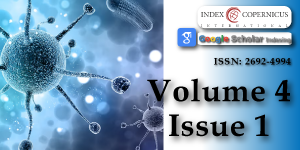Hypothesis about pathogenic action of Sars-COV-2
Main Article Content
Abstract
The Hypothesis born on a simple clinical data noted by some Chinese Reserchers during the starting point of epidemic began in the dicember of the 2019, for the novel member of human coronavirus, officially named as SARS‐CoV‐2 (severe acute respiratory syndrome coronavirus 2) by International Committee on Taxonomy of Viruses (ICTV) is a new strain of RNA viruses that has not been previously identified in humans [1]. Sars-COV and SARS CoV-2 have some clinical differences. First: The Sars, severe acute respiratory sindrome induce a respiratory disease in immunocompetent hosts, although can cause severe infections in infant, young children and elderly individuals; Sars-CoV-2 induce a middle infection into the young children but the mortality is more high in to the adult population. We made a macthing with balst p of these sequences, Sars COV-2, taken on GENEBANK with H1N1 neuraminidase and the not structural protein NS1 and NS2 an interferon antagonist that may also stimulate proinflammatory cytokines in infected cells We can speculate that the mutation is occurred on accessories protein making a different virulence action between the two species Sars Cov and Sars Cov-2, same action we have founded in the H1N1 viral pandemic of the 2019.
Article Details
Copyright (c) 2020 Marasco D, et al.

This work is licensed under a Creative Commons Attribution 4.0 International License.
Zhang JJ, Dong X, Cao YY, Yuan YD, Yang YB, et al. Clinical characteristics of 140 patients infected by SARS-CoV-2 in Wuhan, China. EAACI. 2020.
Cheng VC, To KK, Tse H, Hung IF, Yuen KY. Two years after pandemic influenza A/2009/H1N1: what have we learned? Clin Microbiol Rev. 2012; 25: 223-263. PubMed: https://www.ncbi.nlm.nih.gov/pubmed/22491771
Cui J, Li F, Shi ZL. Origin and evolution of pathogenic coronaviruses. Nat Rev Microbiol. 2019; 17: 181-192. PubMed: https://www.ncbi.nlm.nih.gov/pubmed/30531947
Oldstone MB. Lessons learned and concepts formed from study of the pathogenesis of the two negative-strand viruses lymphocytic choriomeningitis and influenza. Proc Natl Acad Sci USA. 2013; 110: 4180-4183. PubMed: https://www.ncbi.nlm.nih.gov/pubmed/23341590
Xia S, Zhu Y, Liu M, Lan Q, Xu W, et al. Fusion mechanism of 2019-nCoV and fusion inhibitors targeting HR1 domain in spike protein. Cell Mol Immunol. 2020. PubMed: https://www.ncbi.nlm.nih.gov/pubmed/32047258
Oldstone MBA, Ware BC, Horton LE, Welch MJ, Aiolfi R, et al. Lymphocytic choriomeningitis virus Clone 13 infection causes either persistence or acute death dependent on IFN-1, cytotoxic T lymphocytes (CTLs), and host genetics. Proc Natl Acad Sci USA. 2018; 115: E7814-E7823. PubMed: https://www.ncbi.nlm.nih.gov/pubmed/30061383
Xu K, Cai H, Shen Y, Ni Q, Chen Y, et al. Management of corona virus disease-19 (COVID-19): the Zhejiang experience. Zhejiang Da Xue Xue Bao Yi Xue Ban. 2020; 49: 0. PubMed: https://www.ncbi.nlm.nih.gov/pubmed/32096367

